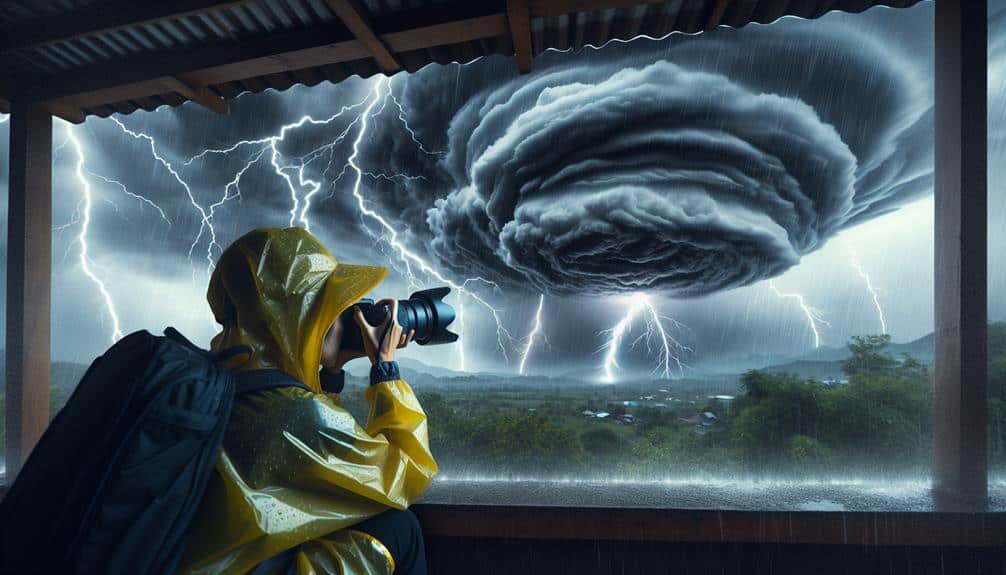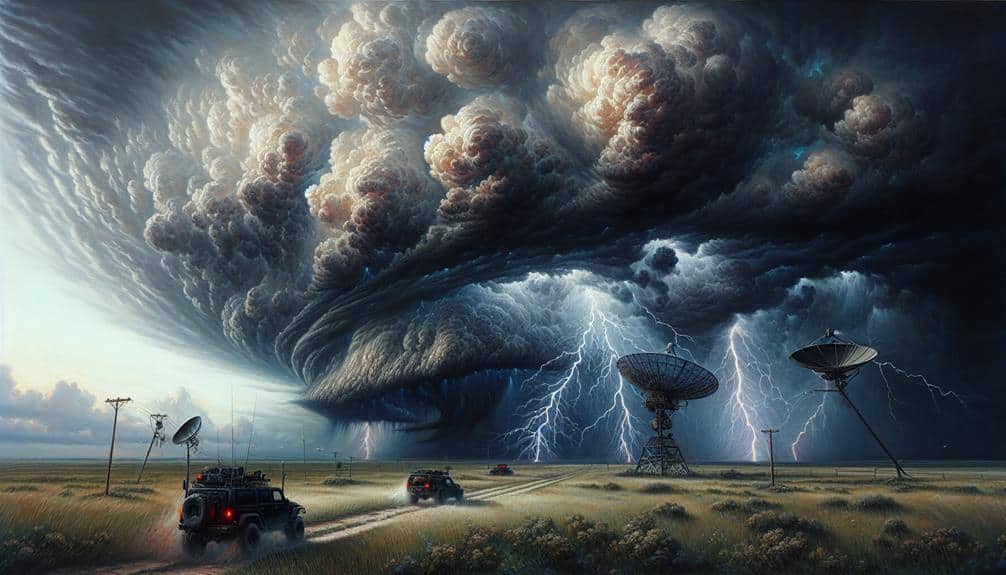To capture stunning severe thunderstorm photography, we must start with the right gear—a weather-sealed DSLR or mirrorless camera and a wide-angle, fast lens. Our chase planning involves analyzing weather data and identifying clear hotspots while ensuring we have multiple escape routes. Understanding weather patterns through Doppler radar, CAPE, and surface observations is essential for predicting storms. We'll focus on composing dramatic shots using the rule of thirds and including foreground elements for depth, then enhance our images with advanced editing. Safety is paramount, so we stay updated with weather alerts and choose safe vantage points. Discover additional expert tips next!
Key Points
- Use a sturdy, weather-sealed DSLR or mirrorless camera with manual settings for optimal control in challenging weather conditions.
- Choose a wide-angle lens and a fast lens with a wide aperture to capture expansive sky shots and low-light scenarios.
- Plan your chase meticulously, analyzing weather forecasts, radar data, and satellite imagery to identify clear vantage points.
- Apply composition techniques like the rule of thirds and include foreground elements to add depth and context to your shots.
Choose the Right Gear
Selecting the appropriate gear is pivotal for capturing high-quality images while ensuring safety during severe thunderstorms. We need to carefully assess camera settings and lighting conditions to achieve the best results. Our camera should be sturdy, preferably weather-sealed, to withstand rain and wind. A DSLR or mirrorless camera with manual settings will give us the control we need over exposure, ISO, and shutter speed.
Let's talk lenses. A wide-angle lens allows us to capture the expansive sky and its dramatic formations. However, a telephoto lens can be invaluable for focusing on specific storm features from a safe distance. Given the unpredictable lighting conditions, a fast lens with a wide aperture (f/2.8 or lower) is ideal for low-light scenarios.
Tripods are non-negotiable. They provide the stability required for long exposure shots, essential for capturing lightning strikes and swirling clouds.
When it comes to camera settings, shooting in RAW format is essential for post-processing flexibility. We should also use a remote shutter release or intervalometer to prevent camera shake and to facilitate time-lapse photography.
Plan Your Chase
To successfully capture severe thunderstorms, we must meticulously plan our chase, taking into account weather forecasts, terrain, and safety protocols.
Effective route planning is essential; we'll need to analyze storm paths through advanced weather tracking systems. By leveraging radar data and real-time satellite imagery, we can chart a safe course that maximizes our chances of encountering the most photogenic storm cells. Timing is vital—arriving too early or too late can mean missing the storm's peak intensity or being caught in dangerous conditions.
Once we've identified potential hotspots, we must consider the terrain. Open areas with minimal obstructions offer the best vantage points, allowing us to capture the breadth and drama of the storm. Meanwhile, we should always have multiple escape routes planned in case the weather turns hazardous.
Equipment selection is another crucial aspect of our preparation. High-quality cameras with storm-proof housing, tripods, and a range of lenses are essential. We should also pack portable power sources and weather-resistant storage for our gear, ensuring we're ready for extended periods in the field.
With our route, timing, and equipment dialed in, we'll be well-prepared to capture the awe-inspiring power of severe thunderstorms while maintaining our safety.
Understand Weather Patterns
Grasping the complexities of weather patterns is essential for accurately predicting where and when severe thunderstorms will occur, allowing us to position ourselves effectively for photography. A deep understanding of atmospheric conditions and storm tracking is vital. By examining meteorological data, we can anticipate the development of severe weather systems.
We use advanced tools like Doppler radar and satellite imagery to monitor atmospheric conditions. Key indicators such as dew point, wind shear, and CAPE (Convective Available Potential Energy) help us determine the potential for thunderstorm development.
- Doppler radar images: These visuals allow us to identify areas of rotation within storms, suggestive of tornado formation.
- Satellite imagery: High-resolution images provide a wide view of storm systems, displaying cloud patterns and movements.
- Weather models: Predictive models like the GFS (Global Forecast System) and the ECMWF (European Centre for Medium-Range Weather Forecasts) offer detailed forecasts.
Understanding these elements not only aids in storm tracking but also ensures we're informed of the associated risks. This knowledge empowers us to chase storms safely and capture the awe-inspiring power of nature on camera.
Compose Dramatic Shots
Capturing the raw intensity of severe thunderstorms necessitates a keen eye for composition to frame the dramatic elements of the storm effectively. We need to follow composition rules like the rule of thirds, which aids in positioning storm clouds, lightning bolts, or funnel clouds for maximum impact.
Creative angles are crucial; shooting from a low angle can highlight the storm's towering nature, while a wide-angle lens can capture the vast expanse and scale of the storm system.
Lighting techniques play a pivotal role in enhancing the drama. Adjusting exposure settings to accommodate the storm's rapidly changing light conditions guarantees we capture crisp, detailed images. Post-processing with advanced editing software allows us to refine these shots further, balancing shadows and highlights to bring out the storm's dynamic range.
Incorporating foreground elements like wind-swept trees or abandoned buildings can add depth and context, making the storm appear even more menacing. We should also experiment with long exposures to capture the movement and intensity of lightning strikes, creating a mesmerizing effect.
Prioritize Safety First

Understanding and respecting the inherent dangers of severe thunderstorms is essential for any photographer aiming to capture these volatile weather events. Our pursuit of stunning imagery shouldn't overshadow the significance of safety. Implementing thorough weather precautions and making sure our equipment is ready for harsh conditions are vital steps.
We must prioritize several safety measures and adopt specific photography techniques to mitigate risks:
- Monitor Weather Alerts: Utilize reliable weather apps to track storm developments and receive real-time alerts. This guarantees we're aware of sudden changes and can take cover if necessary.
- Choose a Safe Vantage Point: Opt for locations with sturdy shelter nearby. Elevated areas may offer great views but also increase lightning strike risks.
- Protective Gear: Equip ourselves with waterproof and wind-resistant gear. Our camera should be in a weather-sealed housing to guard against rain and debris.
Frequently Asked Questions
What Camera Settings Work Best for Severe Thunderstorm Photography?
For severe thunderstorm photography, we use precise focusing techniques, set a small aperture for depth, and balance exposure settings to avoid overexposure. Adjusting white balance choices helps capture the storm's true colors, ensuring stunning images.
How Can I Protect My Gear From Rain and Debris During a Storm?
We prioritize gear protection by using waterproofing techniques and camera covers. Equipment maintenance is essential; we make sure everything is sealed and secure. Staying vigilant about rain and debris keeps us ready to capture the storm's intensity without damage.
What Post-Processing Techniques Enhance Storm Photos?
Did you know that 60% of storm photos benefit from color correction and sharpening? We often use contrast adjustment and noise reduction to enhance details while retaining the raw power of the storm. Let's release our creativity!
Are There Specific Apps for Tracking Severe Thunderstorms?
We rely on storm tracking apps like RadarScope and Storm Shield for real-time weather updates. These apps offer advanced radar data, ensuring we stay informed and safe while capturing severe thunderstorms. Always prioritize safety over the perfect shot.
How Do I Capture Lightning Effectively in My Photos?
It sounds risky, but capturing lightning effectively requires proper lightning composition and creative angles. Use a tripod, set a long exposure, and adjust your aperture and ISO to balance light. Safety first, always!


